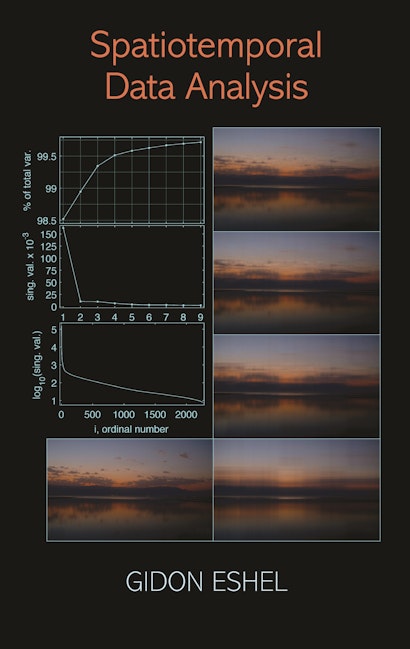A severe thunderstorm morphs into a tornado that cuts a swath of destruction through Oklahoma. How do we study the storm’s mutation into a deadly twister? Avian flu cases are reported in China. How do we characterize the spread of the flu, potentially preventing an epidemic? The way to answer important questions like these is to analyze the spatial and temporal characteristics—origin, rates, and frequencies—of these phenomena. This comprehensive text introduces advanced undergraduate students, graduate students, and researchers to the statistical and algebraic methods used to analyze spatiotemporal data in a range of fields, including climate science, geophysics, ecology, astrophysics, and medicine.
Gidon Eshel begins with a concise yet detailed primer on linear algebra, providing readers with the mathematical foundations needed for data analysis. He then fully explains the theory and methods for analyzing spatiotemporal data, guiding readers from the basics to the most advanced applications. This self-contained, practical guide to the analysis of multidimensional data sets features a wealth of real-world examples as well as sample homework exercises and suggested exams.
Gidon Eshel is Bard Center Fellow at Bard College.
"I believe practitioners and theoreticians from many diverse fields will find the book comprehensive, detailed and beneficial. The material is applicable to a broad range of topics, and the author has a clear presentation with an in-class lecturing tone."—Elvan Ceyhan, Mathematical Reviews Clippings
"Spatiotemporal Data Analysis is based on a lecture course that influenced the thesis work of every graduate student I knew in the department. This is due to the applicability of the material to a broad range of topics, and to Eshel's clear and insightful presentation."—David Archer, University of Chicago
"A perfect and much-needed book for students and professionals tackling the complexities of data analysis in space and time. In my twenty-five years teaching in the environmental sciences, I've not encountered such a comprehensive and well-structured book that eloquently lays out the mathematical basis and data-analysis tools required to understand real-world environmental data structures with practical examples, applications, and problem assignments."—Alfredo Huete, University of Technology Sydney, Australia
"Spatiotemporal Data Analysis is accessible and applicable without sacrificing rigor. The key is a steady stream of well-chosen examples and, most unusual in any textbook, a distinctive narrative voice that guides readers through the material, explaining the details while making sure the big picture is always in view. It will become an essential text for earth scientists and many others who analyze spatiotemporal data."—Mark Cane, Columbia University
"This book offers an excellent survey of the mathematical aspects of spatiotemporal data analysis and will be useful to geoscientists in such applications as collecting, archiving, and interpreting satellite data. While treating some rather abstract matters, Eshel does not drown the reader in overly opaque notation but instead derives results and illustrates them with interesting examples, both numerical and conceptual."—Gerald R. North, Texas A&M University


